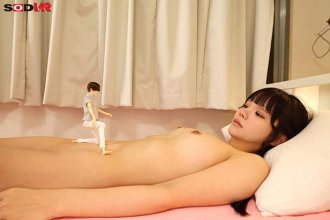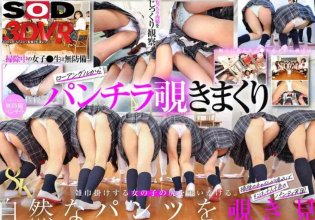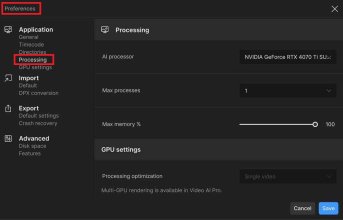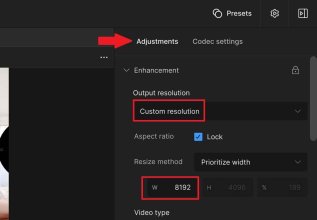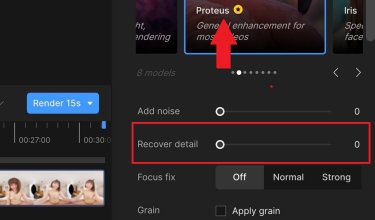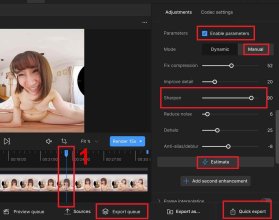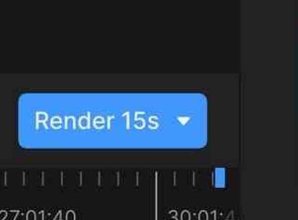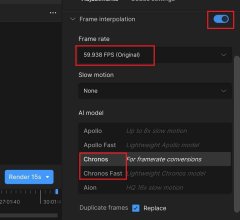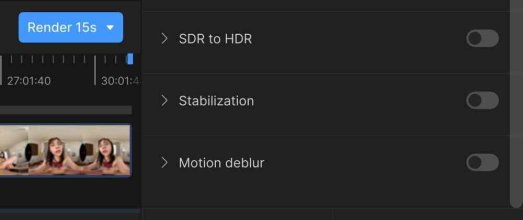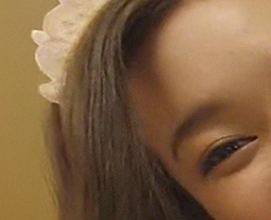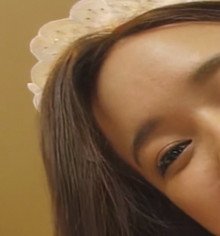Some people are asking me privately what settings I use
to convert 4K to 8K VRs with AI, so I have made this tutorial. It's easy, and you can try the demo.
Keep in mind that the use of AI in VR has nothing to do with what you have seen in 2D video. In flat you see it more defined, and if it is not well done, more artificial. In VR what the AI does is to increase definition and eliminate noise and image blur due to the very low bitrate of Fanza. The result is that your brain stops watching video and you see real girls, so for me it's a brutal leap, especially with older VRs.
In this file I have uploaded a comparison, two videos of 30 seconds of an original 4K VR, and the upgraded 8K version with AI. It's not the best looking one because the original quality is pretty bad, but it's useful for comparison. Comparing in flat is useless, you have to watch it with the headset on.The VR is URVRSP-178 from 2022. I have set the bitrate to 60 Mbps so that everyone can watch it, but I do not recommend less than 80 Mbps, because the image becomes dirty. I use 180 Mbps with my videos:
VR enhanced by IA.ZIP
I use
Topaz AI Video, which is the best for this task. Be careful, it costs 300 euros / dollars and you get one year of updates. If you don't renew, you keep the version you have and you can use it forever. It is expensive, but for me it has been money very well spent. Right now it's discounted, it's down to 250 euros /dollars.
Best of all,
there is a demo that has no limitation of functions and size, although it adds a watermark in the middle of the screen. But you can try it to see what results you get with the tutorial I comment here.
It should be noted that even with a good PC, it is a slow process. We are talking about converting to 8K, a single frame has 8192x4096 = 33.5 million pixels, and the video uses 60 frames per second. The AI has to process 2 billion pixels per second, it's insane.
With my rig, a Ryzen 7 5700X3D and RTX 4070 Ti Super card, which is slowed down by the processor, I get 2.6 fps. This means that a 30 minute video takes about 12 hours to process. It sounds crazy, but for me the result is worth it. Goodbye blurry video, hello girls...

With a more powerful processor or card, you get more speed. Also works on PC and Mac laptops.
It is recommended to use a RTX 3000 card upwards, or its equivalent AMD Radeon. Of course you can also use it at lower resolution and 2D video, and the speed improves a lot. But in VR what we want is maximum realism, that's why you have to opt for 8K video.
Using Topaz IA Video is simple. First we go to the Files menu, Preferences option, Processing, and we make sure that the AI processor is our graphics card (not the CPU) and Max Memory % is 100:
View attachment 3668541
We return to the main screen, and at the top right tap on Codec Settings. We choose H.265 and Constant. The bitrate depends on each one. The higher the bitrate, the lower the image noise. I set 180 Mbps, which is the maximum, but 30 minutes of video fill 40 GB... You can lower it to 60 or 80 Mbps. Lower, you start to notice dirt in the image:
View attachment 3668545
Now we click on Adjustments, and in Output Resolution we set 2X, because we are going from 4K to 8K, or Custom Resolution, and set 8182 x 4086, which is the maximum resolution supported by the H.265 codec, and the one used by Fanza and A Festa:
View attachment 3668550
The last step is to choose the AI model, and configure it. Topaz has 8 AI models, each for different tasks. Note that the tips found on the internet are for 2D video, 3D video in VR is completely different, they are useless.
After hours of testing comparing all the models, the one that gives me the best result is
Proteus in Manual mode and, the key of all, with Sharpen at 80-100. That's a lot for 2D video, but in VR where everything is magnified, it generates a lot of definition without looking artificial.
We continue in Adjustments, and go down to the AI models. We choose
Proteus. It is important to set Recover detail to 0. If you set a value it takes twice as long and does not add anything.
View attachment 3668565
The last step is to customize the AI model. Check the Enable Parameters box, and activate the Manual mode.
Place the blue pointer (marked with a 1 in the picture below) on your favorite part of the video, or the part where it looks the worst, and tap the Estimate button twice (for some reason, one doesn't work). The AI will calculate the best configuration for the place where we have placed the blue mark. The key here is
to move the Sharpen bar between 80-100. I never go below 90.
The last step is to click on Quick Export so that the AI starts working, and come back in 10 or 12 hours...

The best thing to do is to let it work at night.
In Export Queue you can see the progress. Remember to leave free space on the disk where you have the original file:
View attachment 3668585
As you can see, it is not difficult, and everyone can try it with the demo. If someone tries it, please comment on the results...
UPDATE:
FRAME INTERPOLATION
For the example I have started from a 4K VR at 60 fps. But it is possible to start from a 2K or 4K VR at 30 fps and convert it to 60 fps,, as
@Kawaii.kawaii reminded me.
In this case, in the Adjustments section, go down to the bottom to activate the Frame Interpolation option. Here we choose the framerate we want. It must be multiples of two or three. For example, if the original is at 30 fps, use 60 or 90 fps, but if it is at 29.97 fps, something usual, use 59.938 fps, otherwise there will be jumps in the image.
To add frames, it uses an additional AI, Chronos. The Fast version is faster but looks worse, I use the standard version.
With the Slow Motion option you can create slow motion video:
View attachment 3668772
Finally, there are options to convert standard video to HDR, and specific AI to stabilize the image or remove Motion Blur. The first two are not necessary in VR, where the cameras are fixed and the video is very stable. Motion Blur may be of interest in older videos that look blurry when there is motion. Although Proteus itself already removes Motion Blur.
View attachment 3668773







